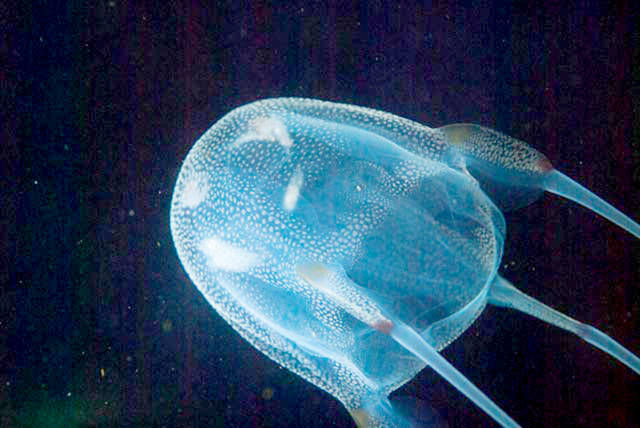MOLOAA — I was sure my right arm caught on fire in Moloa’a Bay Saturday afternoon, and I wasn’t anywhere near a flame.
In fact, it was ladies’ day out and a few of us were splashing around in the reef-protected waters near the shoreline when I felt burning near my elbow.
At the same time, I saw what I thought was a piece of hair, or very thin fishing line wrapped around my arm. Seconds later, I’d brushed off the strand and the burning had spiraled up my arm, wrapping around my fingers.
I never saw the jellyfish that the wayward tentacle was attached to, but the proof of my assailant was in the angry, raised bumps that wrapped around my hand and arm.
Half an hour later, I’d rubbed it ferociously with some sand, tossed water on it, and the pain was subsiding.
When I got home, I covered it in noni extract and basil essential oil mixed with plantain ointment. Within an hour the red bumps disappeared and the itching stopped.
Common knowledge dictates using white vinegar on jellyfish stings, and I don’t know why I didn’t. It was sitting in the cabinet, next to the rest of my remedies.
I was lucky it was a mild sting. My co-worker and fellow reporter John Steinhorst was stung on the same weekend and was dealing with the aftermath days after my sting had healed.
Several kinds of jellies live in the waters around Hawaii, including box jellyfish and the Portuguese Man-O’-War — all which can deliver a painful sting. And box jellyfish are among the deadliest creatures on Earth, according to the University of Hawaii, because of their venom and their color. Many times, people just don’t see a jellyfish in the water until it’s too late.
Some are highly allergic to jellyfish venom as well, and can go into anaphylactic shock if stung in the right place.
Because of that, researchers with UH have been testing treatment methods for the stings.
They’ve discovered heat is one of the best ways to treat and manage jellyfish stings, because it shuts down venom pathways.
“People think ice will help because jelly stings burn and it’s cold,” said researcher Christie Wilcox in a UH release detailing research results. “But, research to date has shown all marine venoms are highly heat sensitive.”
Submerge jellyfish stings should be soaked in water that’s between 40 and 50 degrees Celsius, which is between 102 and 122 degrees Fahrenheit, according to UH researchers.
Signs are posted year-round when a large number of jellyfish are reported at beaches, and on Kauai the only beach that’s usually posted with signs when an influx happens is Poipu Beach.
Along with vinegar and hot water, experts recommend removing tentacle cells from the stung area with a towel or credit card — anything that will scrape them off without re-depositing them onto your skin.
My remedy was rubbing handfuls of sand on my arm, which I think only worked because it was such a mild sting.
From now on, I’ll be keeping some vinegar on hand and a place to find some hot water in mind, just in case another gelatinous animal drifts by to deliver a little zap.
•••
Jessica Else is a reporter for The Garden Island. She can be reached at jelse@thegardenisland.com






